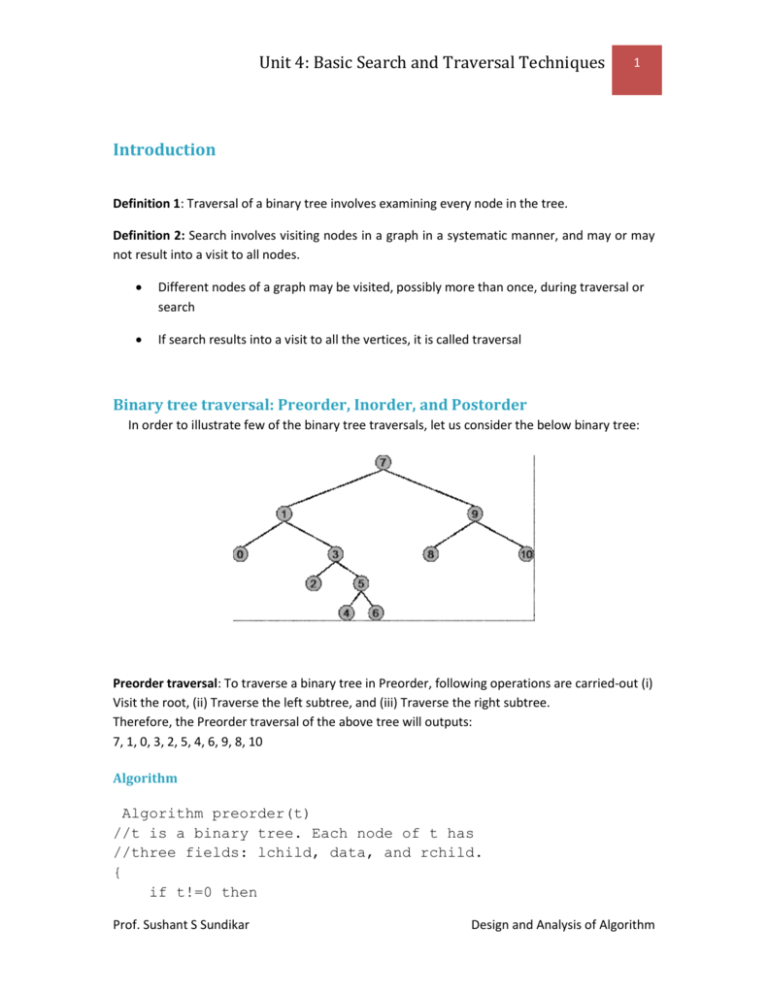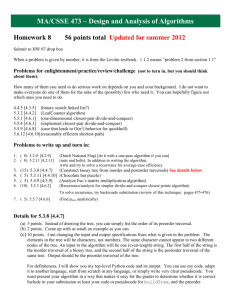Unit 4: Basic Search and Traversal Techniques
advertisement

Unit 4: Basic Search and Traversal Techniques
1
Introduction
Definition 1: Traversal of a binary tree involves examining every node in the tree.
Definition 2: Search involves visiting nodes in a graph in a systematic manner, and may or may
not result into a visit to all nodes.
Different nodes of a graph may be visited, possibly more than once, during traversal or
search
If search results into a visit to all the vertices, it is called traversal
Binary tree traversal: Preorder, Inorder, and Postorder
In order to illustrate few of the binary tree traversals, let us consider the below binary tree:
Preorder traversal: To traverse a binary tree in Preorder, following operations are carried-out (i)
Visit the root, (ii) Traverse the left subtree, and (iii) Traverse the right subtree.
Therefore, the Preorder traversal of the above tree will outputs:
7, 1, 0, 3, 2, 5, 4, 6, 9, 8, 10
Algorithm
Algorithm preorder(t)
//t is a binary tree. Each node of t has
//three fields: lchild, data, and rchild.
{
if t!=0 then
Prof. Sushant S Sundikar
Design and Analysis of Algorithm
Unit 4: Basic Search and Traversal Techniques
2
{
Vist(t);
preorder(t->lchild);
preorder(t->rchild);
}
}
Inorder traversal: To traverse a binary tree in Inorder, following operations are carried-out (i)
Traverse the left most subtree starting at the left external node, (ii) Visit the root, and (iii)
Traverse the right subtree starting at the left external node.
Therefore, the Inorder traversal of the above tree will outputs:
0, 1, 2, 3, 4, 5, 6, 7, 8, 9, 10
Algorithm:
Algorithm inorder(t)
//t is a binary tree. Each node of t has
//three fields: lchild, data, and rchild.
{
if t!=0 then
{
postorder(t->lchild);
Visit(t);
postorder(t->rchild);
}
}
Postorder traversal: To traverse a binary tree in Postorder, following operations are carried-out
(i) Traverse all the left external nodes starting with the left most subtree which is then followed
by bubble-up all the internal nodes, (ii) Traverse the right subtree starting at the left external
node which is then followed by bubble-up all the internal nodes, and (iii) Visit the root.
Therefore, the Postorder traversal of the above tree will outputs:
0, 2, 4, 6, 5, 3, 1, 8, 10, 9, 7
Algorithm:
Algorithm postorder(t)
//t is a binary tree. Each node of t has
Prof. Sushant S Sundikar
Design and Analysis of Algorithm
Unit 4: Basic Search and Traversal Techniques
3
//three fields: lchild, data, and rchild.
{
if t!=0 then
{
postorder(t->lchild);
postorder(t->rchild);
Visit(t);
}
}
Graph Traversal
Depth-First Traversal
Depth-first search (DFS) is an algorithm for traversing or searching a tree, tree structure, or
graph. One starts at the root (selecting some node as the root in the graph case) and explores as
far as possible along each branch before backtracking.
Formally, DFS is an uninformed search that progresses by expanding the first child node of the
search tree that appears and thus going deeper and deeper until a goal node is found, or until it
hits a node that has no children. Then the search backtracks, returning to the most recent node
it hasn't finished exploring. In a non-recursive implementation, all freshly expanded nodes are
added to a stack for exploration.
The time and space analysis of DFS differs according to its application area. In theoretical
computer science, DFS is typically used to traverse an entire graph, and takes time O(|V| + |E|),
linear in the size of the graph.
algorithm
dft(x)
visit(x)
FOR each y such that (x,y) is an edge DO
IF y was not visited yet THEN
dft(y)
A recursive algorithm implicitly recording a “backtracking” path from the root to the node
currently under consideration
Prof. Sushant S Sundikar
Design and Analysis of Algorithm
Unit 4: Basic Search and Traversal Techniques
Prof. Sushant S Sundikar
4
Design and Analysis of Algorithm
Unit 4: Basic Search and Traversal Techniques
Prof. Sushant S Sundikar
5
Design and Analysis of Algorithm
Unit 4: Basic Search and Traversal Techniques
6
Algorithm for Depth First Search
Algorithm DFS(v)
//Given an undirected(directed)graph G=(V,E) with
//n vertices and an array visited[] initially set
//to zero, this algorithm visits all vertices
//reachable from v. G and visited[] are global.
{
visited[v]:=1;
for each vertex w adjacent from v do
{
if(visited[w]=0) then DFS(w);
Prof. Sushant S Sundikar
Design and Analysis of Algorithm
Unit 4: Basic Search and Traversal Techniques
7
}
}
Breadth-First Traversal
BFS is an uninformed search method that aims to expand and examine all nodes of a graph or
combination of sequences by systematically searching through every solution. In other words, it
exhaustively searches the entire graph or sequence without considering the goal until it finds it.
It does not use a heuristic algorithm.
From the standpoint of the algorithm, all child nodes obtained by expanding a node are added
to a FIFO (i.e., First In, First Out) queue. In typical implementations, nodes that have not yet
been examined for their neighbors are placed in some container (such as a queue or linked list)
called "open" and then once examined are placed in the container "closed".
Space complexity
Since all of the nodes of a level must be saved until their child nodes in the next level have been
generated, the space complexity is proportional to the number of nodes at the deepest level.
Given a branching factor b and graph depth d the asymptotic space complexity is the number of
nodes at the deepest level, O(bd). When the number of vertices in the graph is known ahead of
time, and additional data structures are used to determine which vertices have already been
added to the queue, the space complexity can also be expressed as O( | V | ) where | V | is
the cardinality of the set of vertices. In the worst case the graph has a depth of 1 and all vertices
must be stored. Since it is exponential in the depth of the graph, breadth-first search is often
impractical for large problems on systems with bounded space.
Time complexity
Since in the worst case breadth-first search has to consider all paths to all possible nodes the
time complexity of breadth-first search is
The time complexity can also be expressed as O(
edge will be explored in the worst case.
Prof. Sushant S Sundikar
which is
O(bd).
| E | + | V | ) since every vertex and every
Design and Analysis of Algorithm
Unit 4: Basic Search and Traversal Techniques
8
Completeness
Breadth-first search is complete. This means that if there is a solution, breadth-first search will
find it regardless of the kind of graph. However, if the graph is infinite and there is no solution
breadth-first search will diverge.
Visit the nodes at level i before the nodes of level i+1.
visit(start node)
queue <- start node
WHILE queue is nor empty DO
x <- queue
FOR each y such that (x,y) is an edge
and y has not been visited yet DO
visit(y)
queue <- y
END
END
Prof. Sushant S Sundikar
Design and Analysis of Algorithm
Unit 4: Basic Search and Traversal Techniques
Prof. Sushant S Sundikar
9
Design and Analysis of Algorithm
Unit 4: Basic Search and Traversal Techniques
10
Algorithm for Breadth First Search
Algorithm BFS(v)
//A breadth first search of G is carried out beginning
//at vertex v. For any node i, visited[i] = 1 if i has
//already been visited. The graph G and array visited[]
//are global;visited[] is initialized to zero.
{
u:=v; //q is a queue of unexplored vertices.
visited[v]:=1;
repeat
{
for all vertices w adjacent from u do
{
if(visited[w]=0) then
{
Add w to q; //w is unexplored.
visited[w]:=1;
}
}
if q is empty then return;// No unexplored vertex.
Prof. Sushant S Sundikar
Design and Analysis of Algorithm
Unit 4: Basic Search and Traversal Techniques
11
Delete u from q;//Get first unexplored
vertex.
} until(false);
}
AND/OR graph
Definition
An AND/OR graph G is a directed graph with a special node s, called the start (or root) node,
and a nonempty set of terminal leaf nodes t, t1, t2,....
The start node s represents the given problem to be solved
The terminal leaf nodes correspond to subproblems with known solutions.
The nonterminal nodes m, n, p,q,r,... of G are of three types: OR, AND, and nonterminal
leaf.
o An OR node can be solved in any one of a number of alternative ways,
o An AND node is solved only when every one of its immediate subproblems is
solved.
o A nonterminal leaf node has no successors and is unsolvable.
Note: it seems that "AND/OR graph" and "AND/OR tree" are used interchangeably
A solution graph D(m) with root m is a finite subgraph of G with the following properties
m is in D(m)
for any OR node in D(m), D(m) should contain exactly one its immediate successor in G
for any AND node in D(m), D(m) should have all its immediate successors in G.
every maximal (direct) path in D(m) ends in a terminal leaf node.
Prof. Sushant S Sundikar
Design and Analysis of Algorithm






![Question#4 [25 points]](http://s3.studylib.net/store/data/007289590_1-57e227b5dac30eb17dd4115b9416253c-300x300.png)